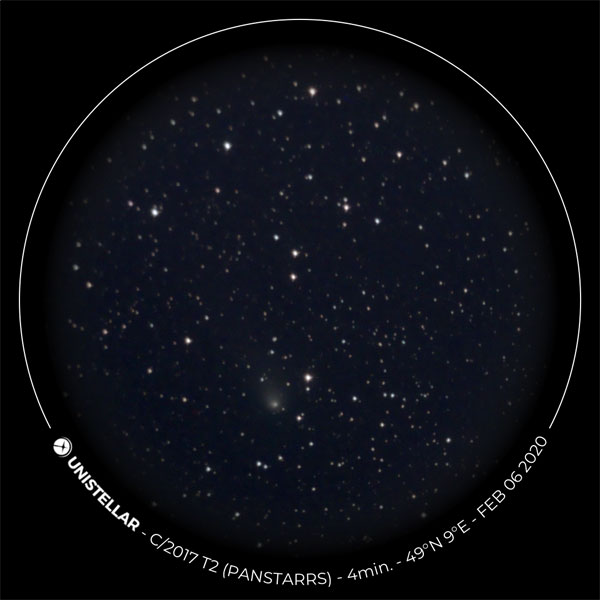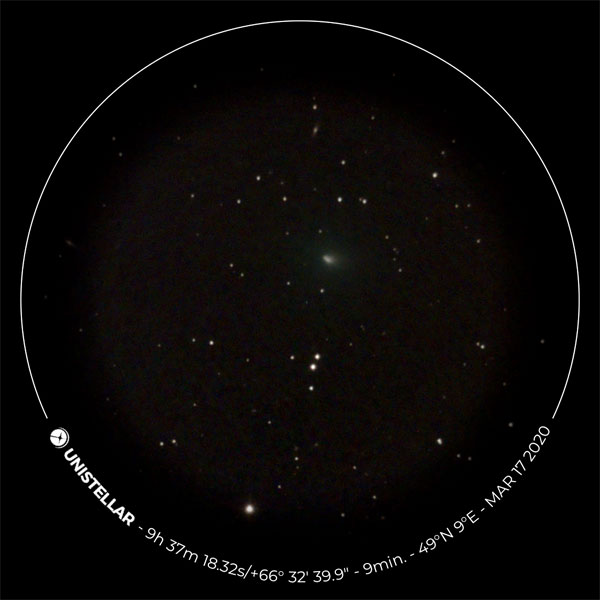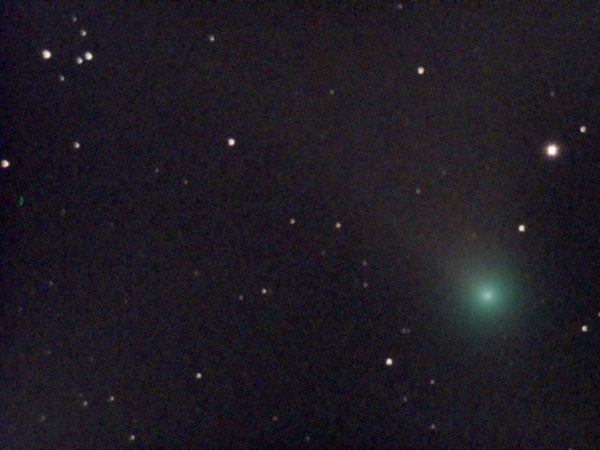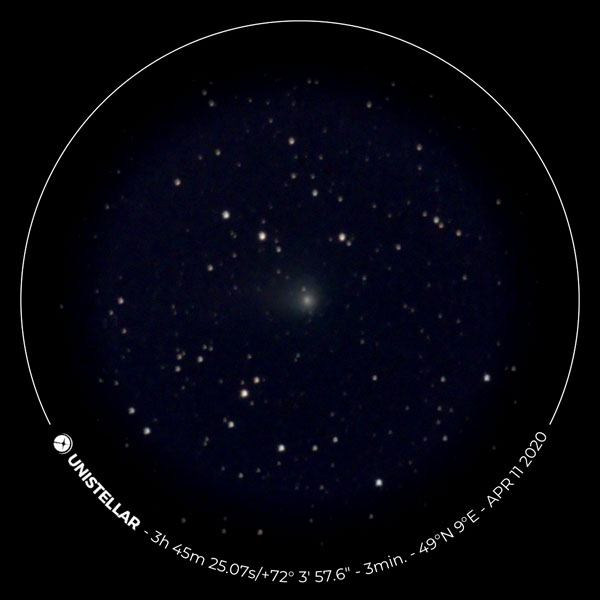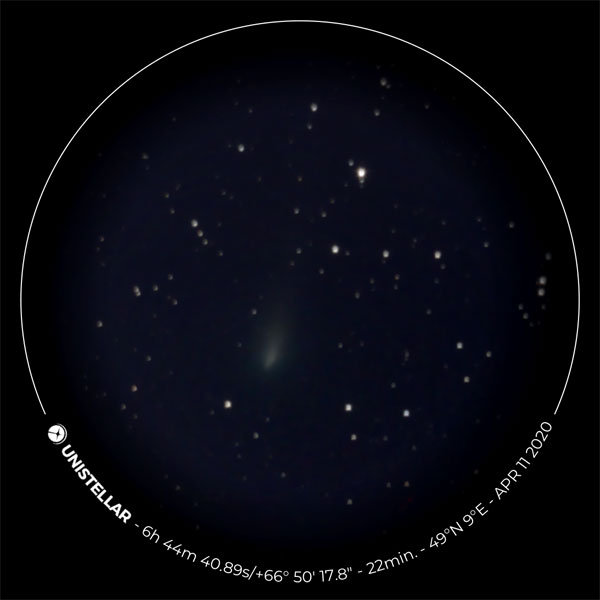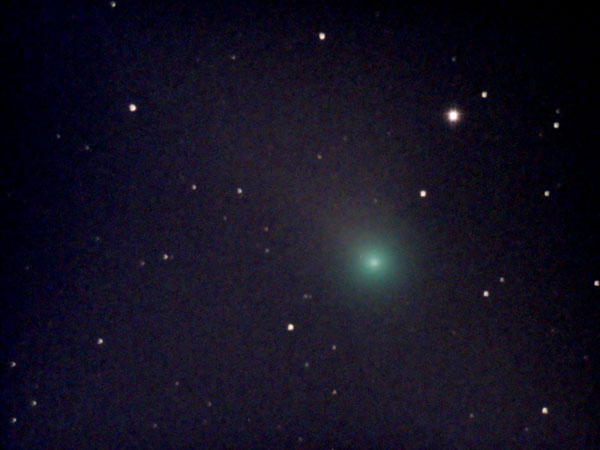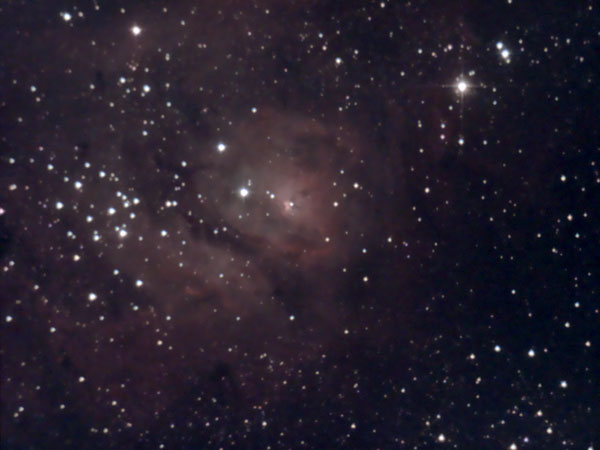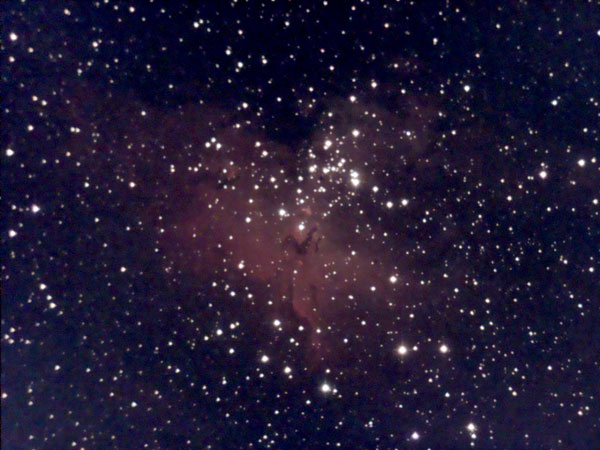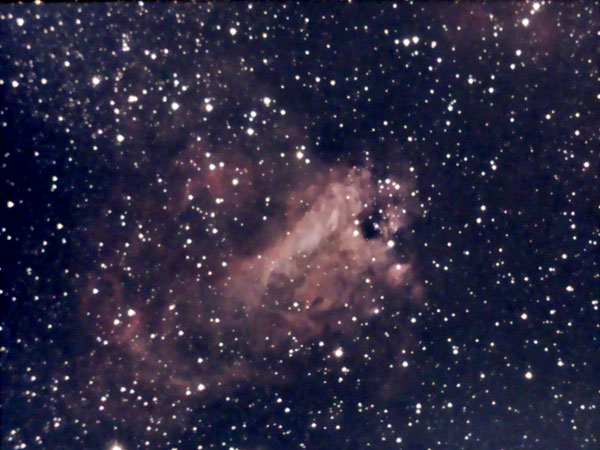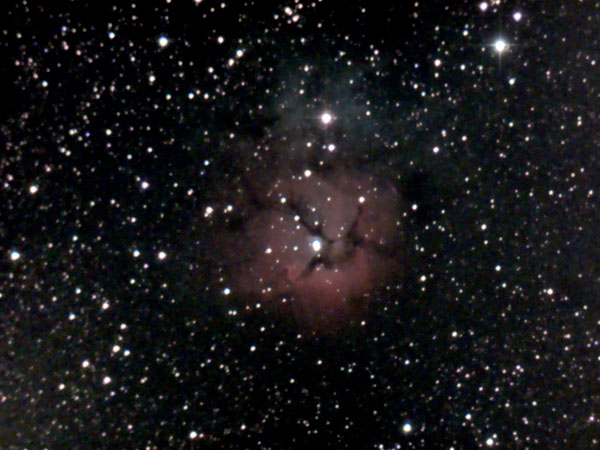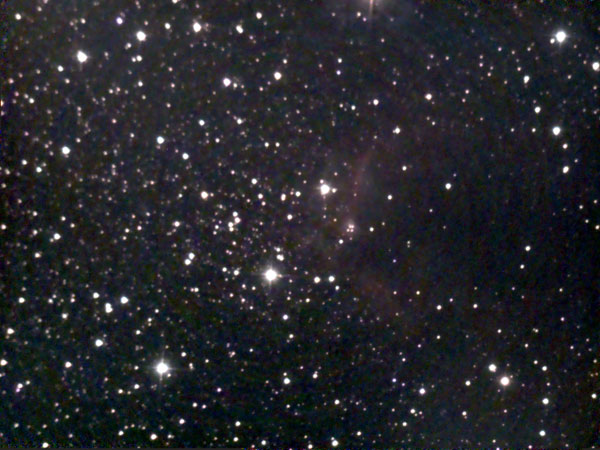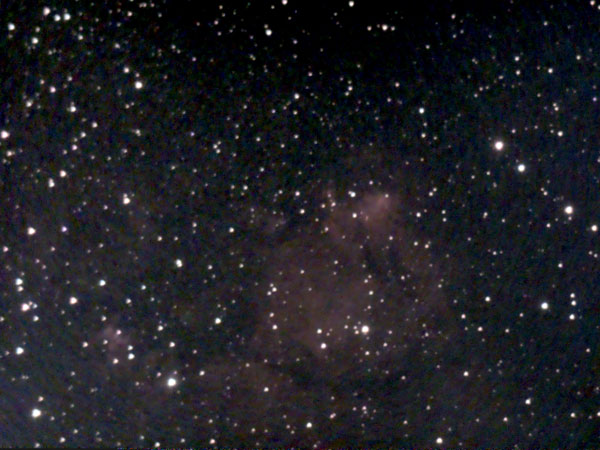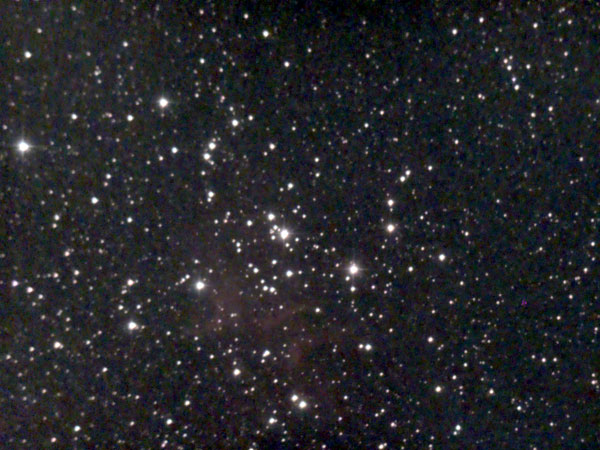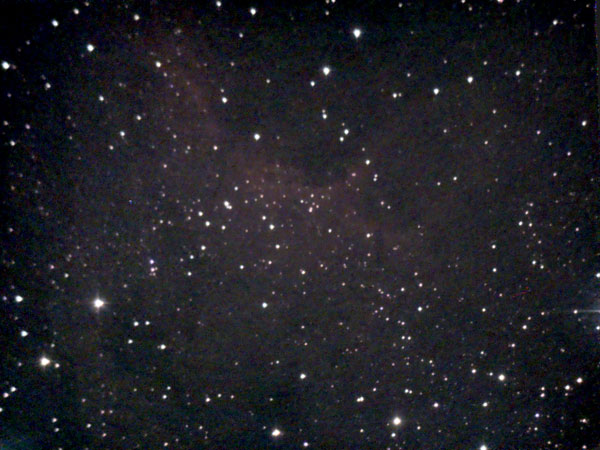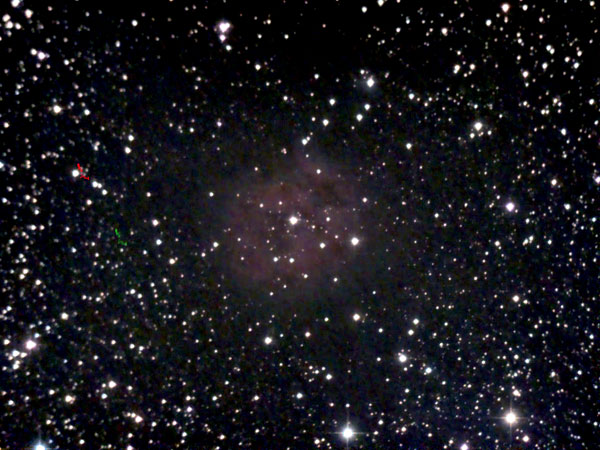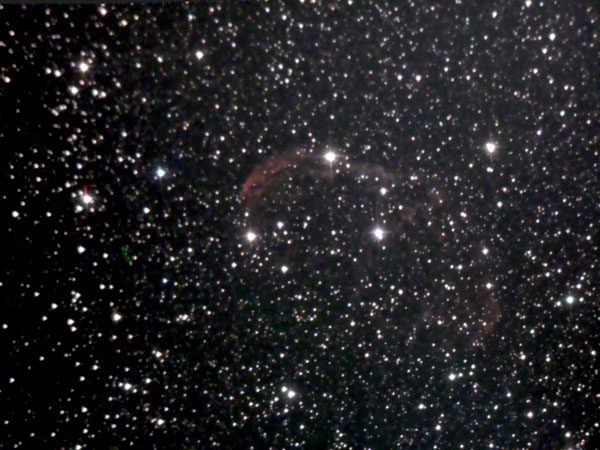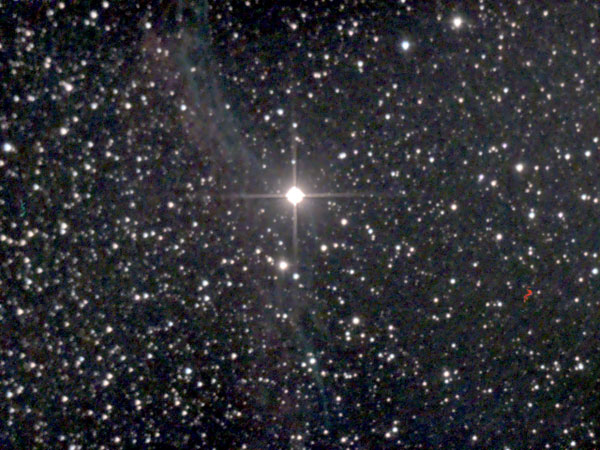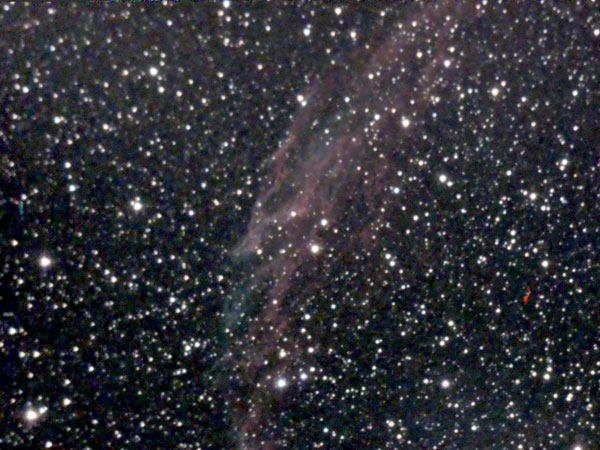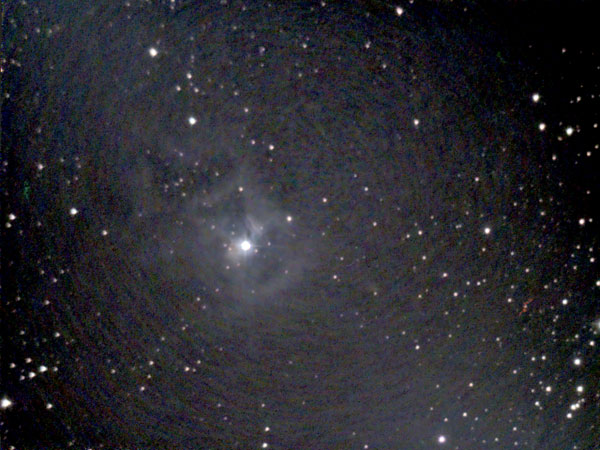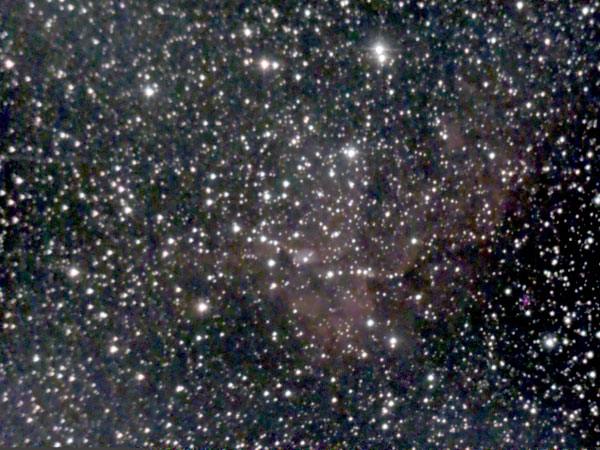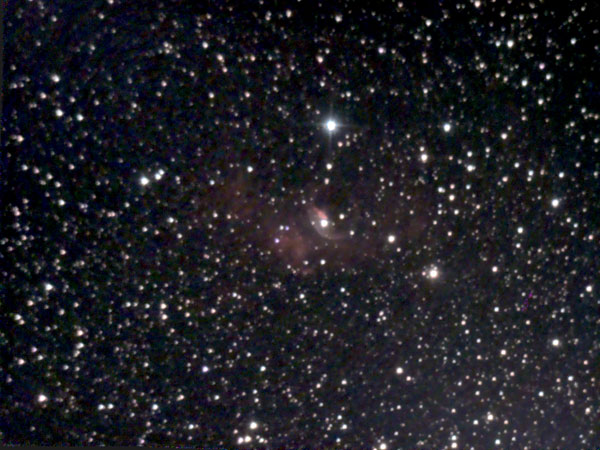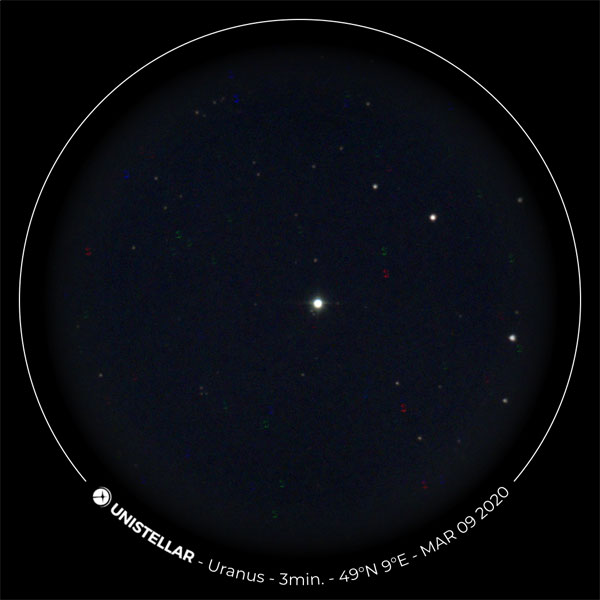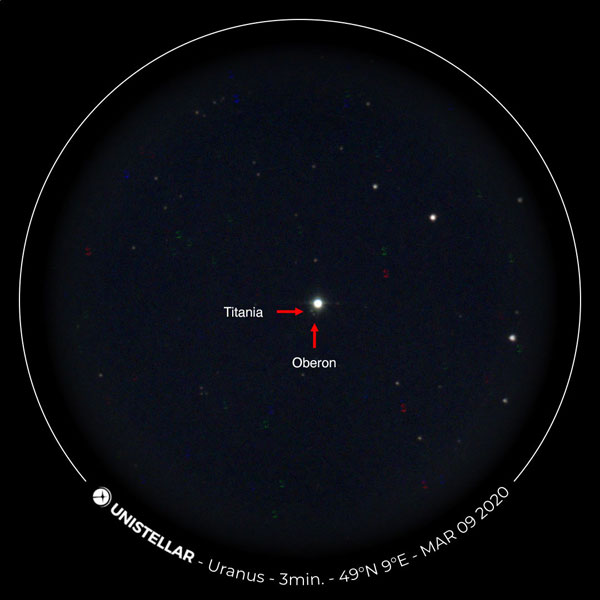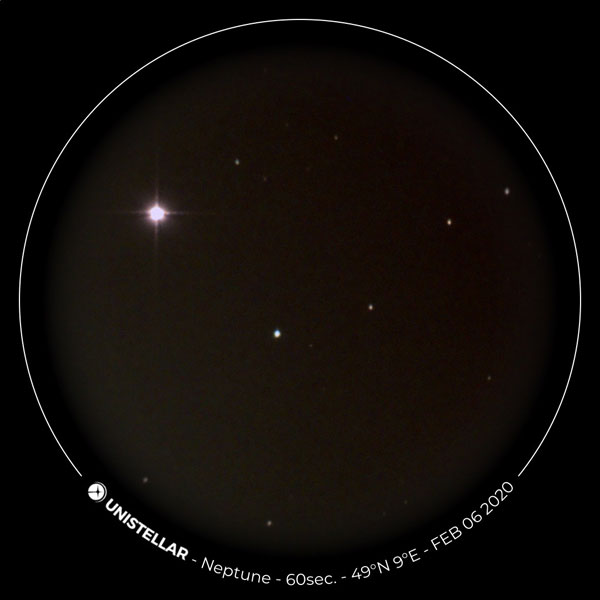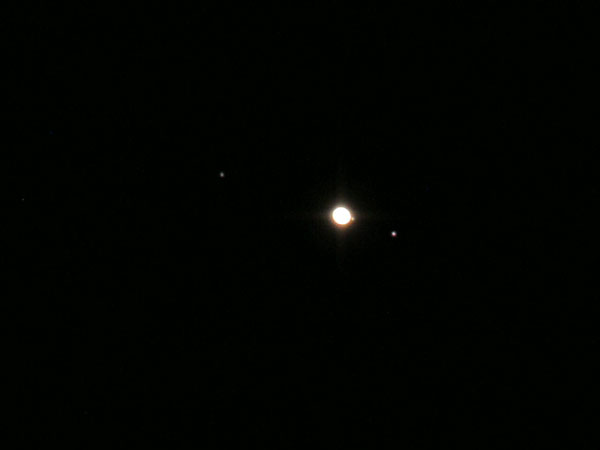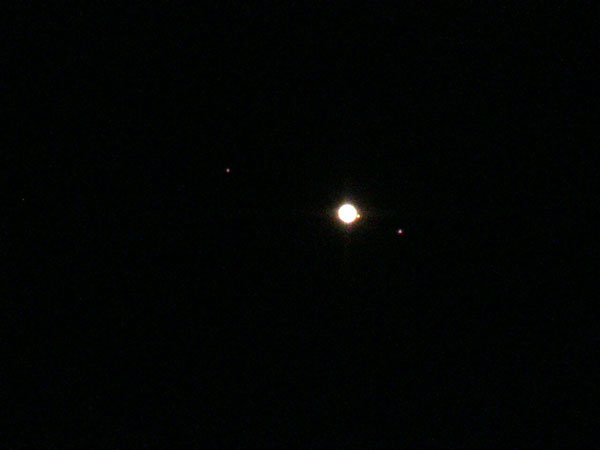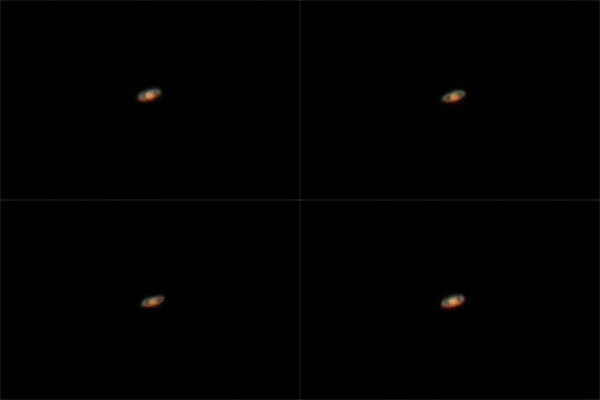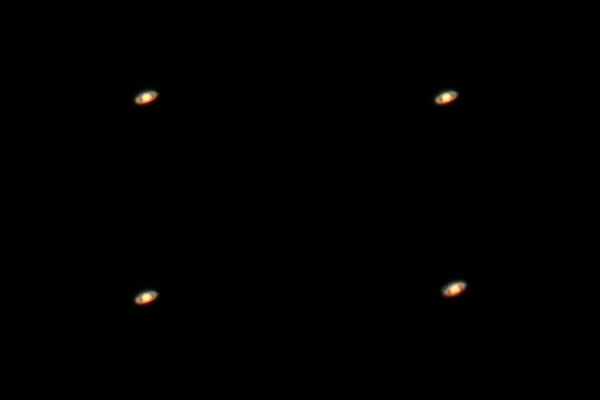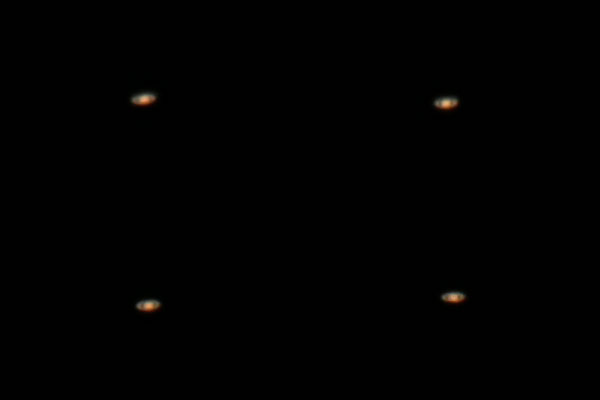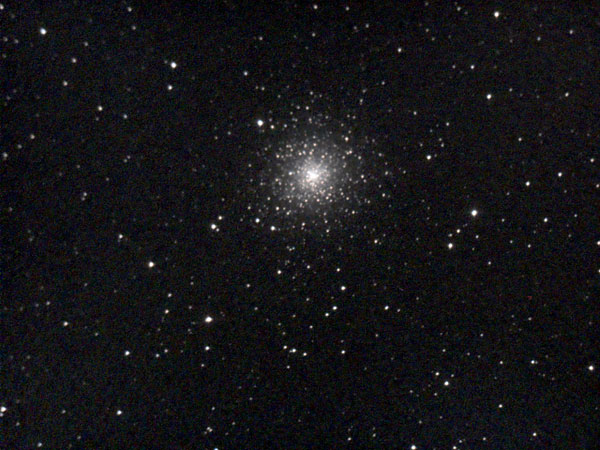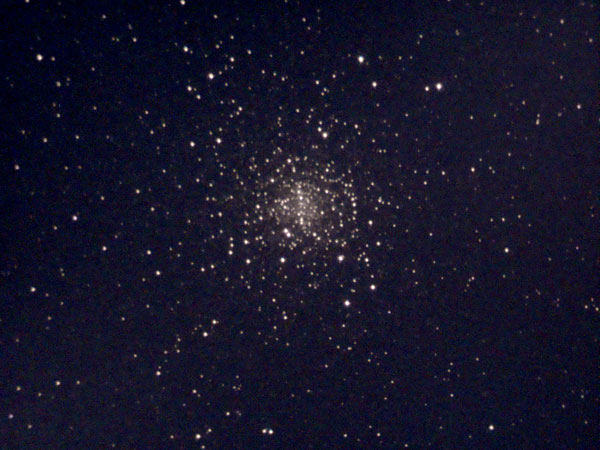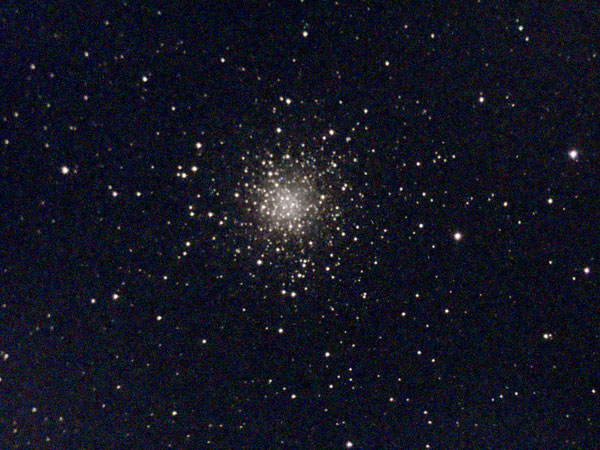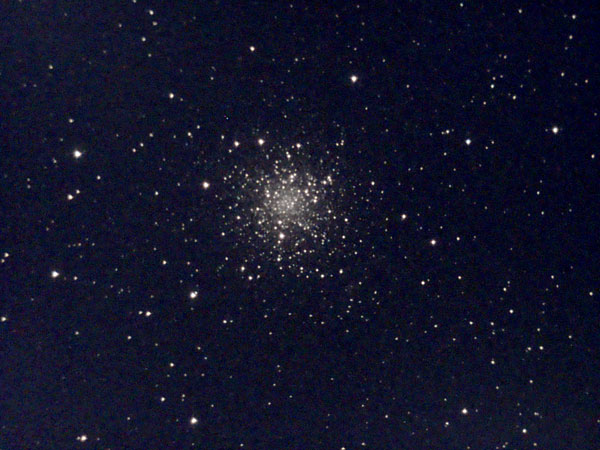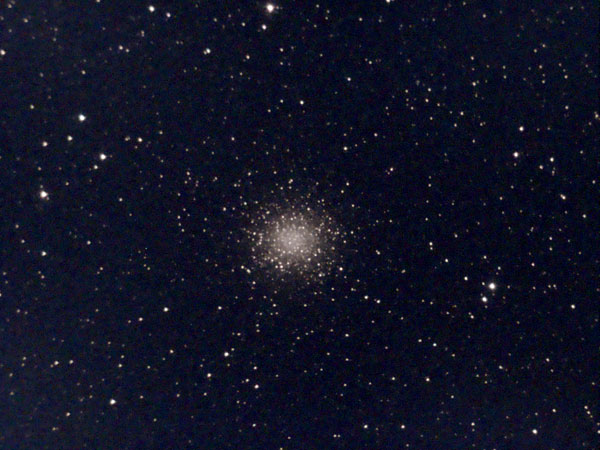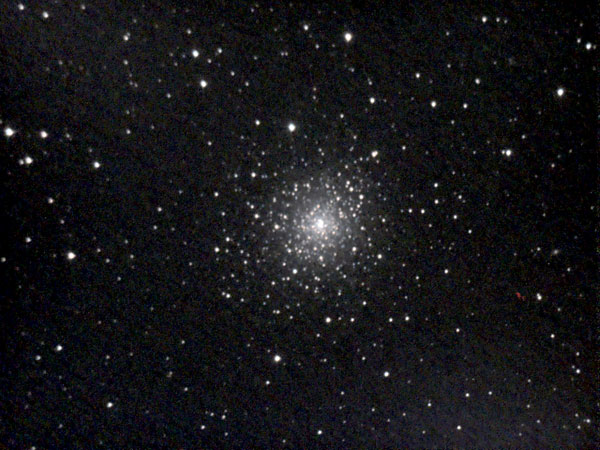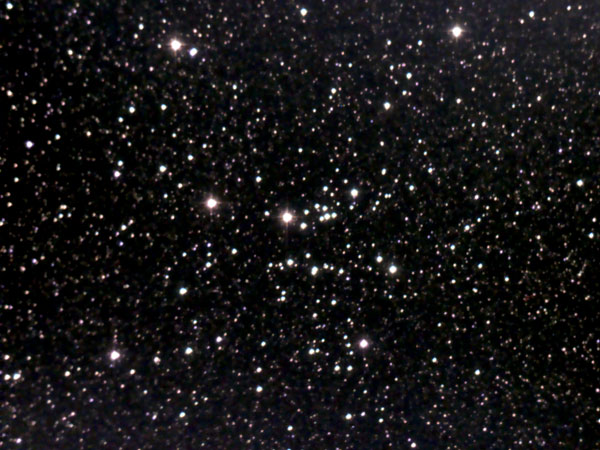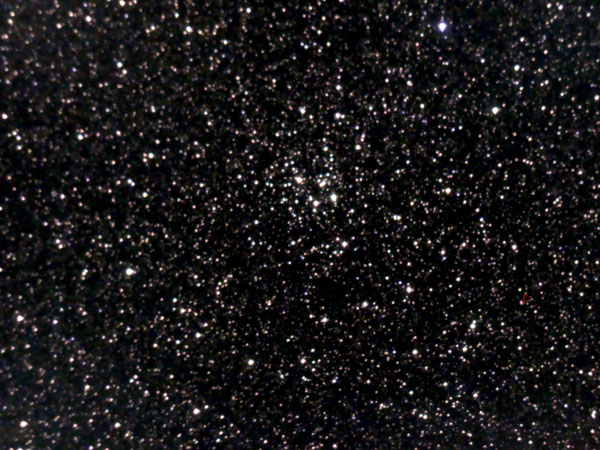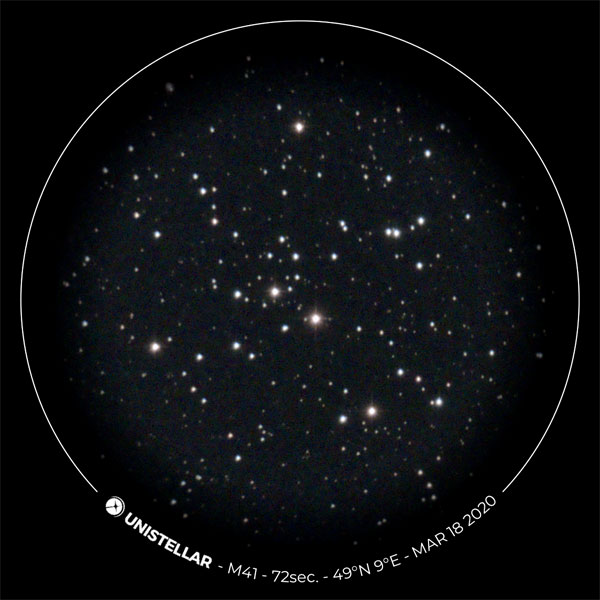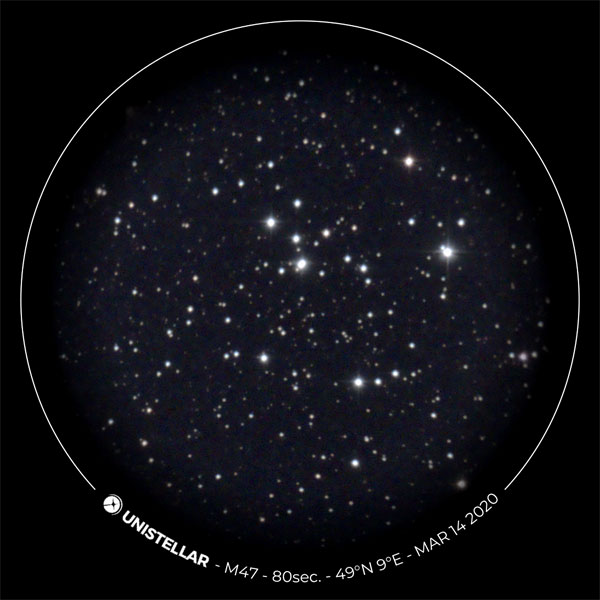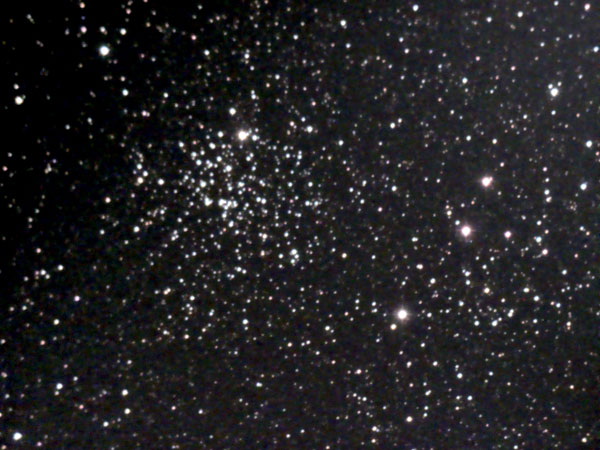Unistellar eVscope - Specialties Gallery Part 1
On this page, I present special DSO taken with my Unistellar eVscope. The list is redundant with other galleries, but here I point to objects that are in one or the other respect "special" or put objects of the same type together to demonstrate their similarity or variety. I also add short texts.
Note: As I sold my eVscope in mid-March 2022, no more new photos will be added.
I present other "special" objects on pages Unistellar eVscope - Specialty Gallery Part 2 (galaxies) and Unistellar eVscope - Specialty Gallery Part 3 (multiple galaxies).
Note: See page Overview of the Unistellar Pages for just that!
Photos
Comets in 2020
Here are the descriptions of the comets:
- The comet C/2017 T2 (PANSTARRS) was discovered on October 2, 2017 with the 1.8-m Pan-STARRS1 telescope in Haleakala, Hawaii. It is expected to become brighter than 10th magnitude during the long period from December 2019 to August 2020 and will move in northern regions of the night sky. From December 2019 to June 2020 it was circumpolar for Central Europe.
- The comet C/2019 Y5 (ATLAS) was discovered on 28.12.2019 by the Asteroid Terrestrial-impact Last Alert System on Hawaii, ATLAS for short. It broke unexpectedly.
- The comet C/2020 F3 (NEOWISE) or Comet NEOWISE was discovered on March 27, 2020, by astronomers during the NEOWISE mission of the re-activated Wide-field Infrared Survey Explorer (WISE) space telescope. By July 2020, the comet was bright enough to be visible to the naked eye. Under dark skies, it could be seen with the naked eye and remained visible to the naked eye throughout most of July 2020. For observers in the northern hemisphere, the comet could be seen on the northwestern horizon, below the Big Dipper.
A Nebula like a Comet...
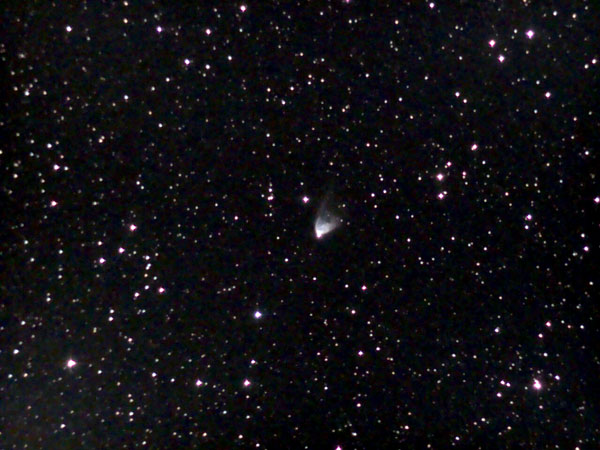 |
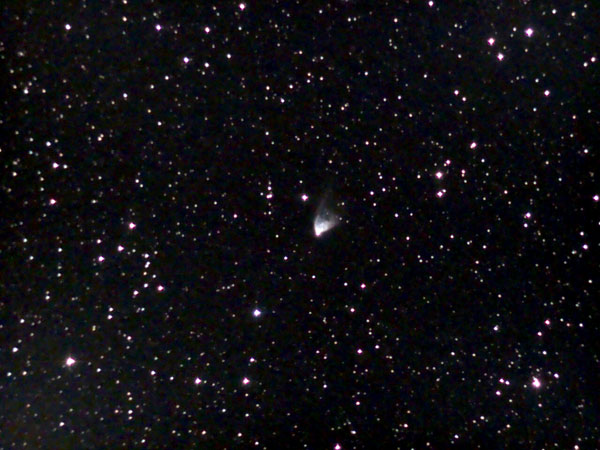 |
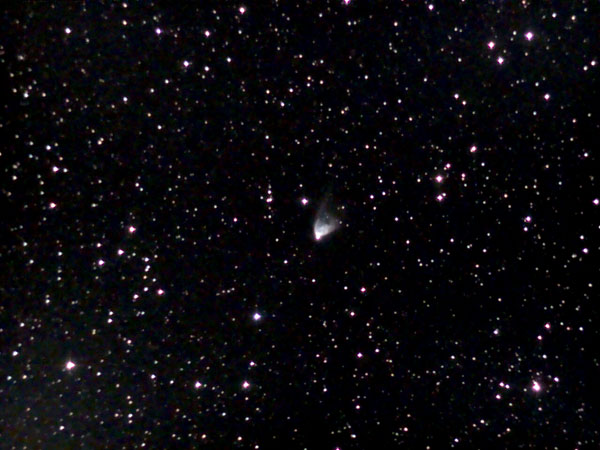 |
||
NGC 2261 - Mar 8, 2021, processed |
NGC 2261 - Mar 8, 2021, processed |
NGC 2261 - Mar 8, 2021, processed |
The galactic reflection nebula NGC 2261 in the constellation Monoceros / Unicorn, is called Hubble's Variable Nebula because it changes in detail. But this is only visible in large telescopes. The special thing about this nebula is its shape, which resembles a comet.
Nebulae in the Constellations Orion and Taurus
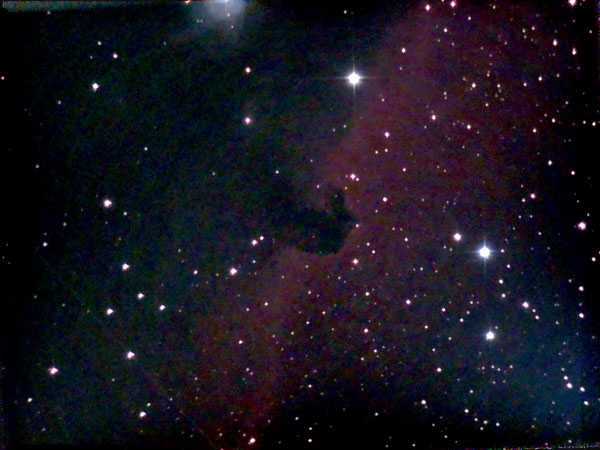 |
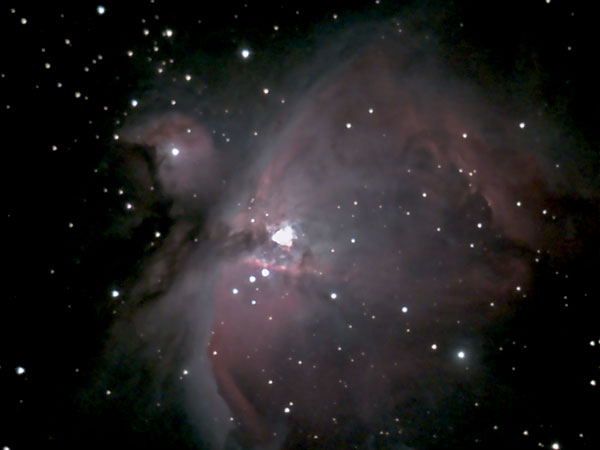 |
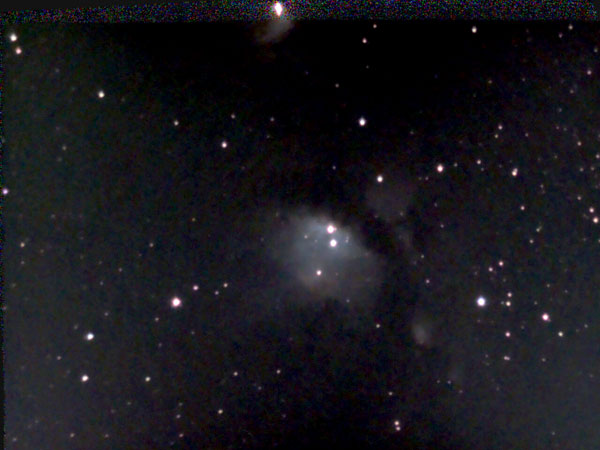 |
||
B 33 - Mar 8, 2021 - processed |
M 42 - Nov 17, 2020, processed |
M 78 - Mar 7, 2021, processed |
||
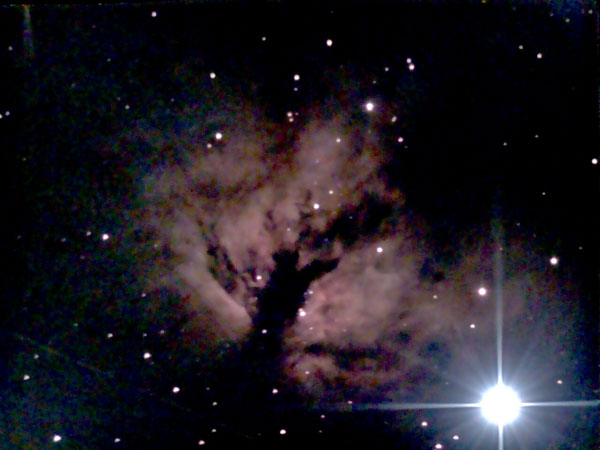 |
 |
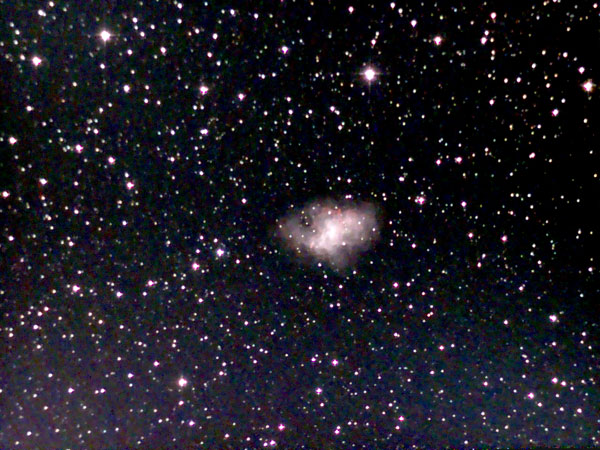 |
||
NGC 2024 - Mar 7, 2021, processed |
NGC 1977 - Mar 8, 2021, processed |
M 1 - Mar 6, 2021, processed |
Here are the descriptions of the nebulae:
- The Horse Head Nebula B 33 is part of a dark cloud in the constellation Orion, which stands out in front of the red glowing emission nebula IC 434 with a silhouette similar to a horse head.
- The galactic emission/reflection nebula NGC 2024 in the constellation Orion, is called Flame Nebula. It is located next to the belt star Alnitak; it is therefore easy to find, but difficult to observe because the bright star outshines it.
- The Orion Nebula M 42 together with its "annex" M 43 (Mairan's Nebula) is probably the largest galactic emission nebula in the northern sky. It is found in Orion's sword, that is, in the constellation Orion, and at least the sword is usually visible to the naked eye.
- The galactic emission/reflection nebula NGC 1977 (with its parts NGC 1975 and NGC 1973) in the constellation Orion is called Running Man Nebula because of the form of a dark nebula inside of it.
- The galactic reflection nebula M 78 in the constellation Orion was hard to find with visual telescopes; with the eVscope I could see more details under a dark sky.
- The galactic emission nebula M 1 (NGC 1952), also known as Crab Nebula, in the constellation of Taurus is a supernova remnant from 1054.
Large Nebulae
Here are the descriptions of the nebulae:
- According to Stoyan, the Lagoon Nebula M 8, being the brightest nebula, and the brightest open star cluster embedded in it "unite to the most awesome field in Sagittarius." Unfortunately, I was not able to see much of it. In France, I found, at least, the open star cluster. In the eVscope, I also found the nebula.
- According to Stoyan, M 16 (NGC 6611) is considered as the most beautiful open star cluster in the constellation Serpens/Serpent (Serpens Cauda/Tail of the Serpent). Usually, however, it is simply called "Eagle Nebula" after the galactic nebula IC 4703, the Eagle Nebula, in which it is embedded.
- M 17 (NGC 6618) is a galactic emission nebula in the Sagittarius constellation, which, according to Stoyan, is by many observers counted among the best nebulae of this type. The name Swan Nebula describes its form in a reversing telescope, but the name Omega Nebula, which dates back to William Herrschel, seems to be the more common one.
- The galactic emission nebula M 20 in the constellation Sagittarius is called Trifid Nebula because it consists of three parts.
- The galactic nebula Caldwell 9 (Cave Nebula) in the constellation Cepheus is a diffuse nebula in the constellation Cepheus, within a larger nebula complex containing emission, reflection, and dark nebulosity.
- The galactic nebulae IC 1805 (Heart Nebula, IC 1848 (Soul Nebula; not shown) and IC 1795 (NGC 896, Fish Head Nebula) form a larger nebulosity region in the constellation Cassiopeia, not far away from the Perseus Double Cluster NGC 869/884. The Fish Head Nebula (IC 1795, NGC 896), next to IC 1805, is the brightest region and was therefore discovered first.
- The galactic emission nebula IC 5070 (Pelican Nebula) in the constellation Cepheus is, according to Stoyan, a faint nebular region.
- The galactic emission nebula IC 5146 (Cocoon Nebula) in the constellation Cepheus has an open star cluster, named Cr 470, embedded.
- The galactic emission nebula NGC 6888 (Crescent Nebula) in constellation Cygnus is faint and better suited to larger telescopes.
- The galactic emission nebula NGC 6960/6992/5, called Cirrus or Veil Nebula, in the constellation Cygnus/Swan is a compound of the galactic nebulae NGC 6960 and NGC 6992/5. According to Stoyan, a labyrinth of weak nebulae and fine filaments is distributed over a larger area, but this can only to recognized under good observation conditions. I was able to catch at least a glimpse of NGC 6960 and of NGC 6995 with the eVscope, although all this is far too large for the eVscope's field of view.
- NGC 7023 is the name of an open star cluster containing the Iris Nebula in the constellation Cepheus. The Iris Nebula is a reflection nebula illuminated by a central star of apparent magnitude 7.1 mag.
- The galactic nebula NGC 7380 (Wizard Nebula) in the constellation Cepheus is a star formation region and contains the young open star cluster NGC 7380.
- The galactic emission nebula NGC 7635 (Bubble Nebula) in the constellation Cassiopeia is located close to the well-known open star cluster M 52 and looks like a bubble.
Planetary "Rainbow Nebulae" and an Owl
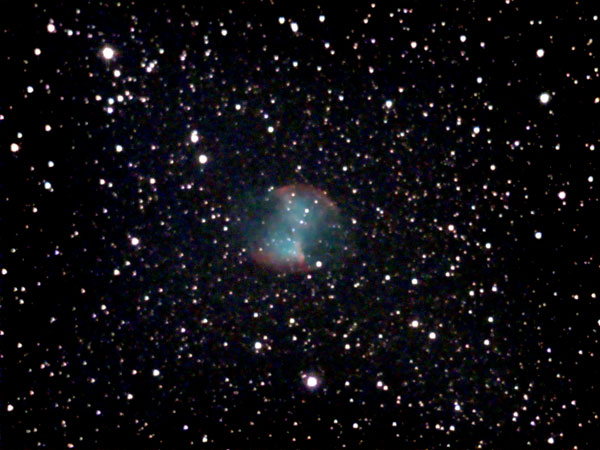 |
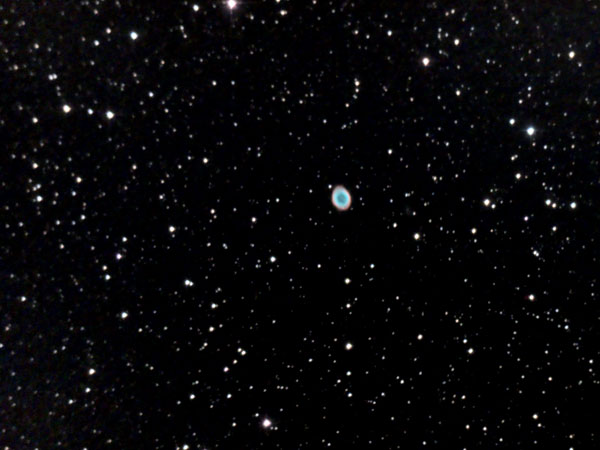 |
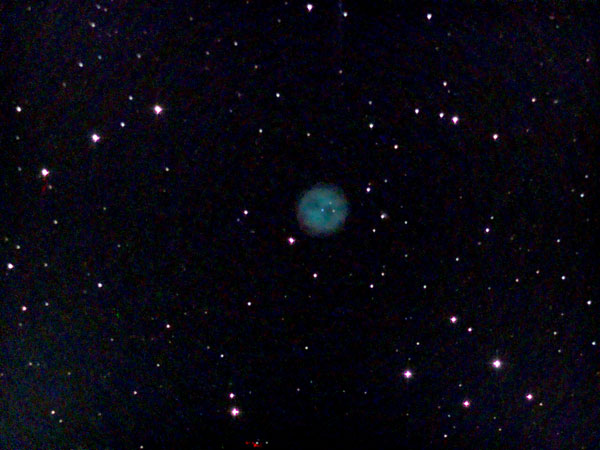 |
||
M 27 - Nov 24, 2020, processed |
M 57 - Aug 24, 2020, processed |
M 97 - Mar 6, 2021, processed |
||
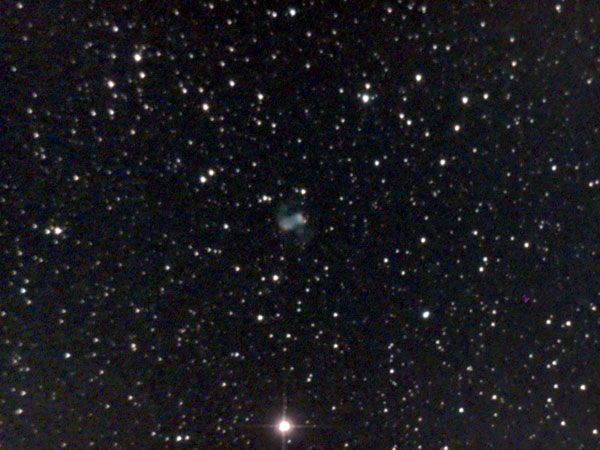 |
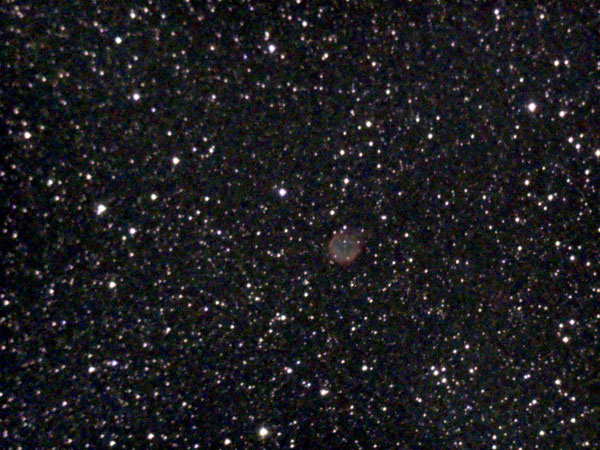 |
|||
M 76 - Sep 15, 2020, processed |
NGC 6781 - Sep 12, 2020, processed |
|
Here are the descriptions of the planetary "rainbow nebulae" and the owl:
- The planetary nebula M 27 in the constellation Vulpecula/Little Fox is called Dumbbell Nebula because of its shape. According to Stoyan, it is considered as one of the most beautiful nebulae for telescope observers.
- The planetary nebula M 76, called Small Dumbbell Nebula, is located in the constellation Perseus and the faintest one of the four planetary nebulae in Messier's catalogue. It got its name because it resembles the much larger Dumbbell Nebula M 27.
- The Ring Nebula M 57 in the constellation Lyra is a planetary nebula and in interesting observation object, because, under favorable conditions, you may be able to recognize a ring structure. However, I only saw the ring really well at the observatory in Betz, France with a larger telescope.
- The planetary nebula NGC 6781 (Snowball Nebula) in the constellation Aquila is, according to Stoyan, the brightest of four fainter planetary nebulae in this constellation. It reminds me of the Ring and the Dumbbell nebulae.
- The planetary nebula M 97 (Owl Nebula) in the constellation Ursa Major is one of four planetary nebulae in the Messier catalogue and the second faintest of these. In the eVscope it appears like a greenish dot with two darker spots.
A Small Collection of Planetary Nebulae...
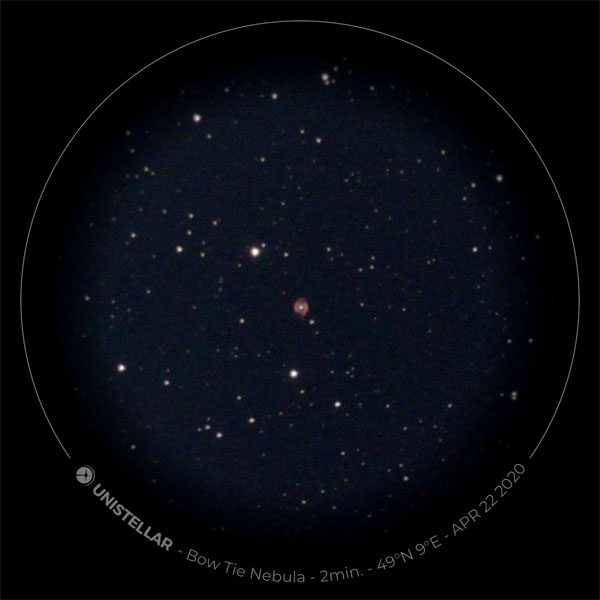 |
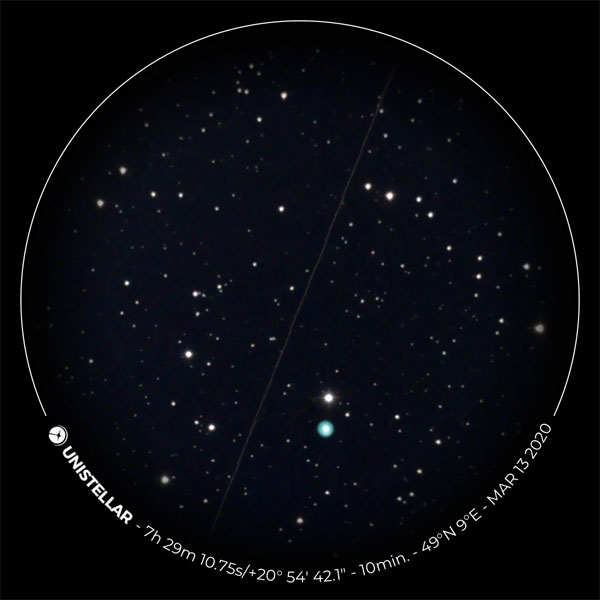 |
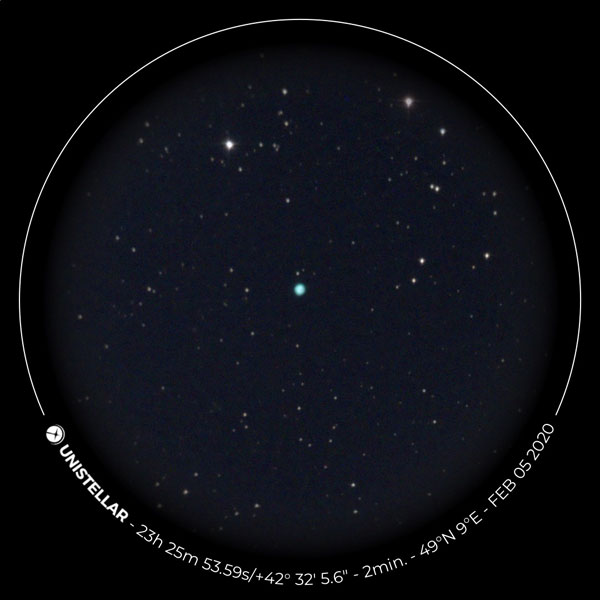 |
||
NGC 40 - Apr 22, 2020, processed |
NGC 2392 - Mar 13, 2020 |
NGC 7662 - Feb 5, 2020 |
||
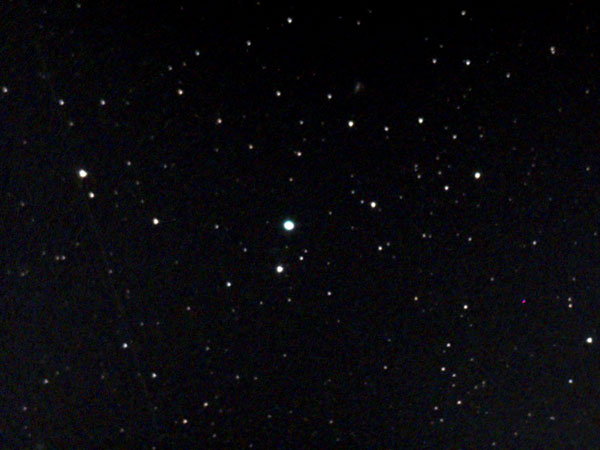 |
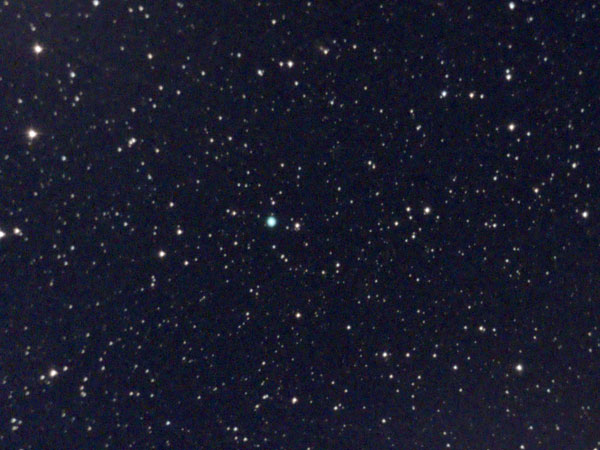 |
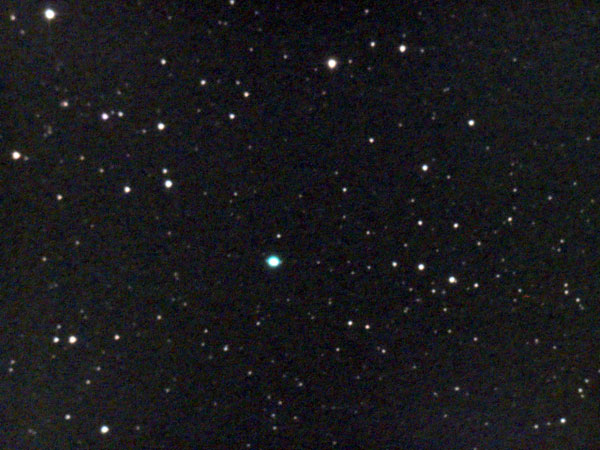 |
||
NGC 6543 - 14.9.2020, processed |
NGC 6826 - Jun 11, 2020, processed |
NGC 7009 - Aug 24, 2020, processed |
Here are the descriptions of the planetary nebulae:
- The planetary nebula NGC 40 (Bow Tie Nebula) in the constellation Cepheus is hard to find with normal telescopes. For GoTo telescopes like the eVscope this is not a problem. In the eVscope, NGC 40 appears violet, and the central star is visible.
- The planetary nebula NGC 2392, called Eskimo Nebula, in the constellation Gemini/Twins is the brightest planetary nebula in the winter sky. But it is a very small nebula, so that one has to use a relatively high magnification in order to recognize something. In a large telescope its sight reminds of an Eskimo, in the eVscope you only see a small bruise...
- The planetary nebula NGC 7662 (Blue Snowball Nebula) in the constellation Andromeda is according to Stoyan is, according to Stoyan, one of the most beautiful planetary nebulae in the autumn sky, which appears in the small telescope as an even blue disc. In the eVscope it appears as a prominent but small blue spot.
- The planetary nebula NGC 6543 (Cat's Eye Nebula) in the constellation Draco is very small in the eVscope.
- The planetary nebula NGC 6826, called Blinking Planetary Nebula, in the constellation Cygnus is according to Stoyan brighter than the Ring Nebula M 57, but not so easy to observe. In the eVscope it is just a small blue dot...
- The planetary nebula NGC 7009 (Saturn Nebula) constellation Aquarius is very small and with its "ears" reminds of the planet Saturn.
A Planetary Nebula in an Open Star Cluster
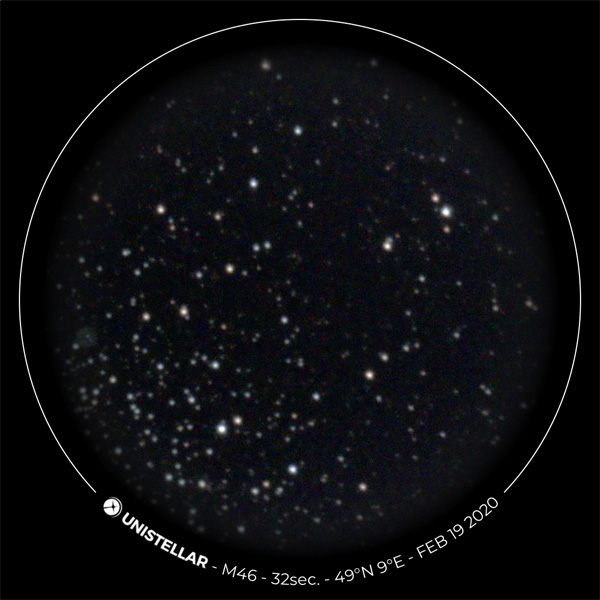 |
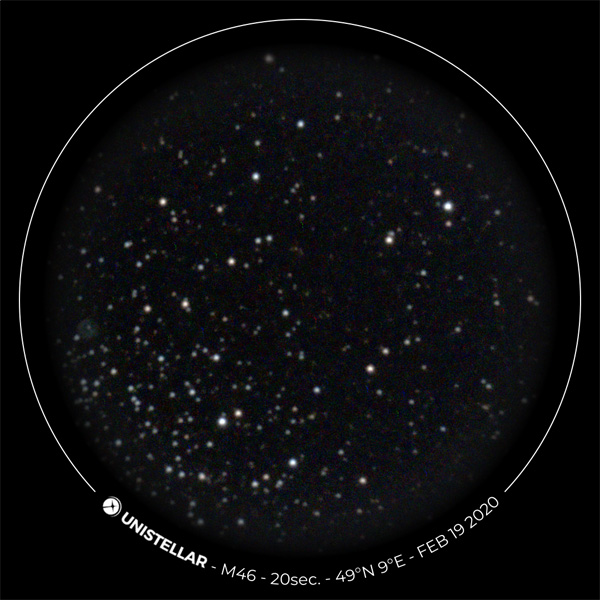 |
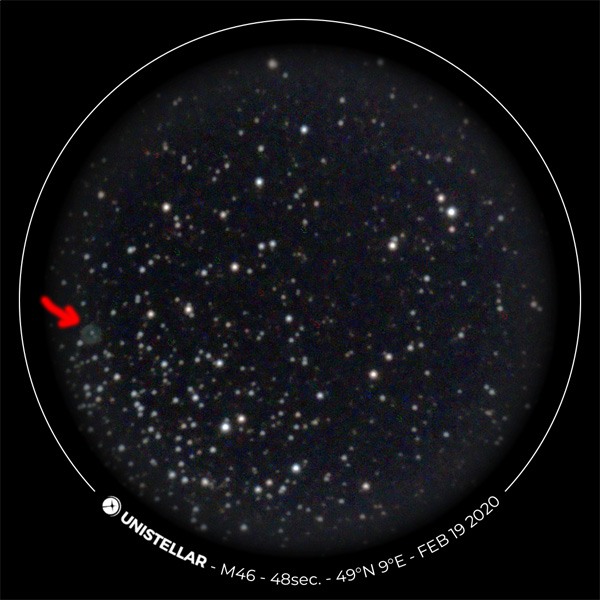 |
||
M 46/NGC 2438 - Feb 19, 2020 |
M 46/NGC 2438 - Feb 19, 2020 |
|
M 46/NGC 2438 - Feb 19, 2020, NGC 2438 marked |
The open star cluster M 46 in the constellation Puppis includes visually the planetary nebula NGC 2438, which I did not find at first. But in February 2020, I was able to discover it on a photo that I took with the eVscope!
Planets
Descriptions:
- Uranus is very small in the eVscope (but larger than Neptune), but at a closer look, you can find the two moons Titania und Oberon on the photo.
- Neptune is very small in the eVscope an reminds of small blue planetary nebulae...
- Jupiter is larger, but you cannot observe the moons and surface details at the same time/settings.
- Saturn is clearly smaller than Jupiter, but with manual exposure you can see the ring.
Large Globular Star Clusters
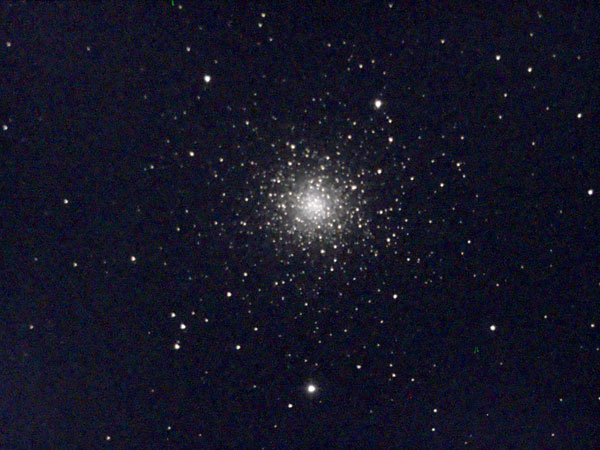 |
||||
M 2 - Aug 24, 2020, processed |
M 3 - May 15, 2020, processed |
M 4 - May 29, 2020, processed | ||
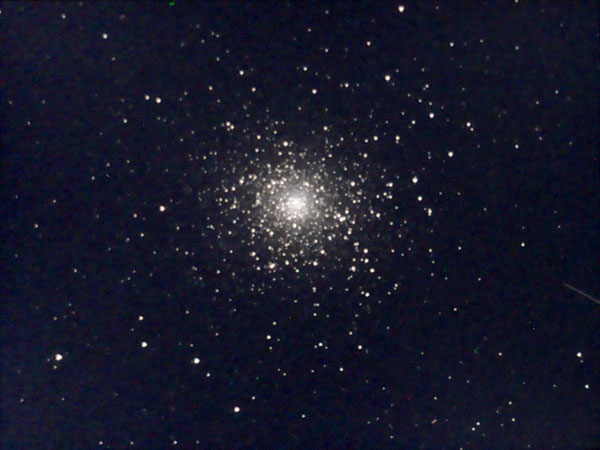 |
||||
M 5 - May 15, 2020, processed |
M 10 - May 29, 2020, processed |
M 12 - Jun 11, 2020, processed |
||
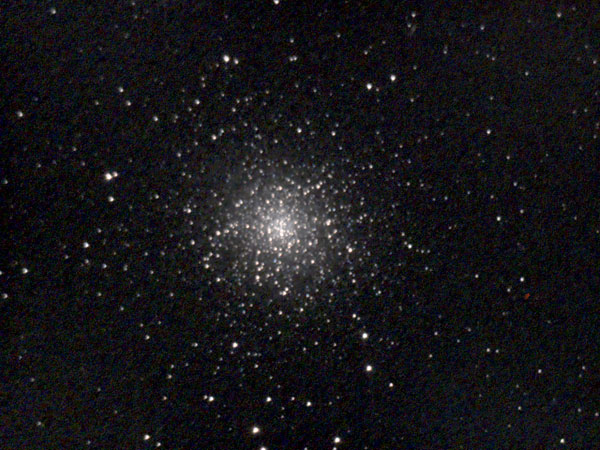 |
||||
M 13 - Sep 15, 2020, processed |
M 14 - Jun 11, 2020, processed |
M 15 - Aug 24, 2020, processed |
||
M 22 - Aug 24, 2020, processed |
M 55 - Sep 8, 2020, processed |
M 92 - Aug 25, 2020, processed |
Here, I present photos of the (on photos) largest globular star clusters from the Messier catalog - without any descriptions of the objects (these can be called using the links).
Nice Open Star Clusters
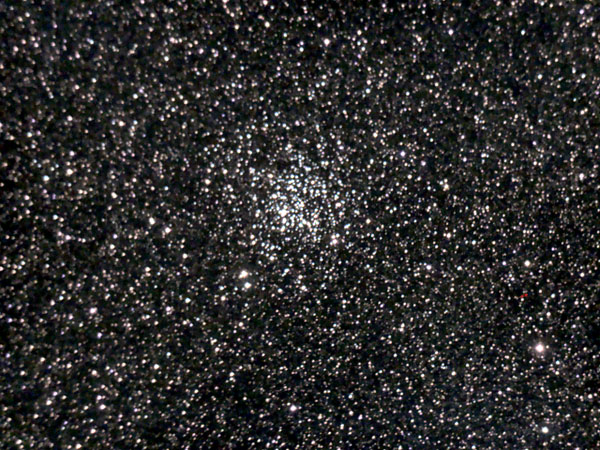 |
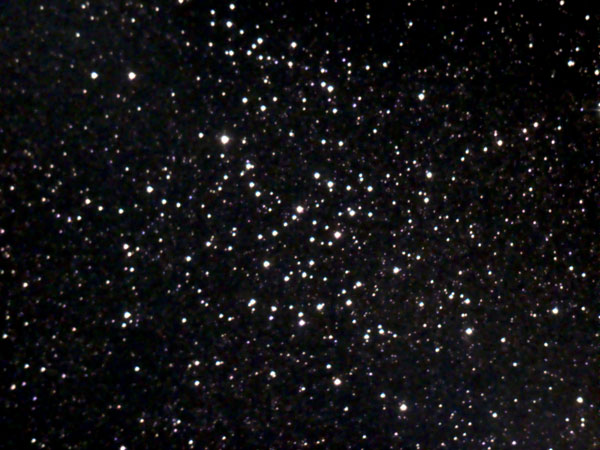 |
|||
M 11 - Aug 23, processed |
M 23 - Aug 23, processed |
M 25 - Aug 23, processed |
||
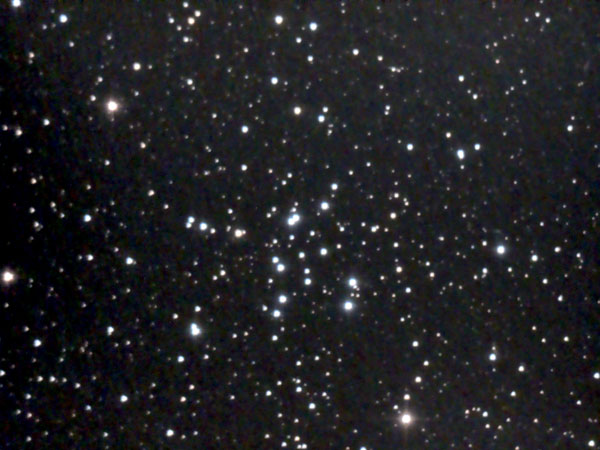 |
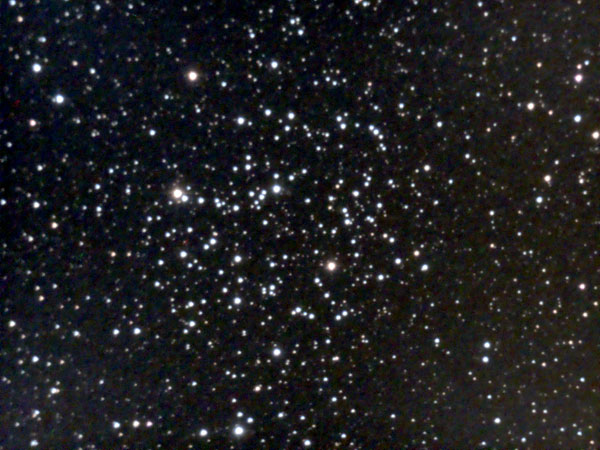 |
|||
M 26 - Aug 23, 2020, processed |
M 34 Sep 18, 2020, processed |
M 35 - Nov 17, 2020, photo left processed |
||
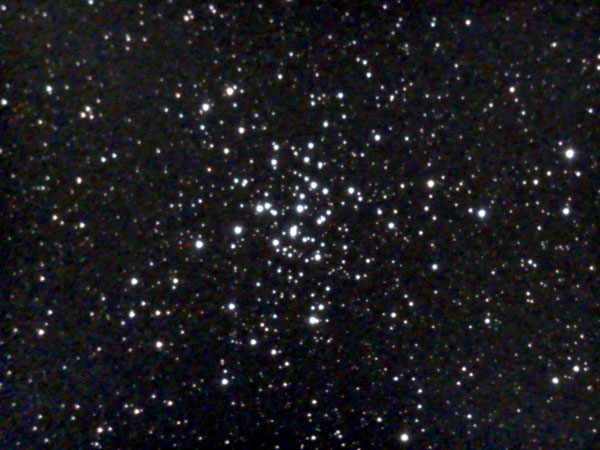 |
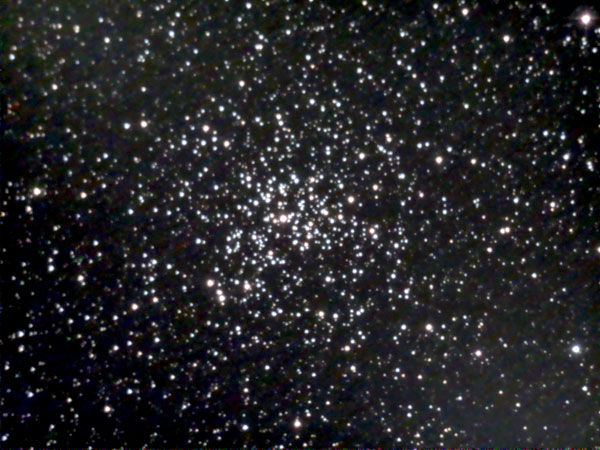 |
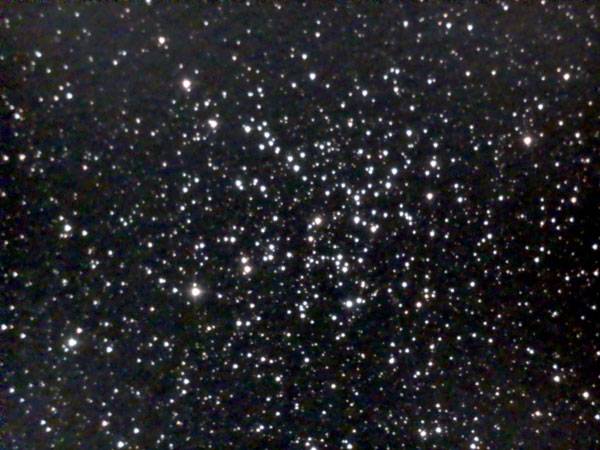 |
||
M 36 - Nov 17, 2020, processed |
M 37 - Nov 17, 2020, processed |
M 38 - Nov 17, 2020, processed |
||
 |
||||
M 41 - Mar 18, 2020, processed |
M 47 - Mar 14, 2020, processed |
M 48 - Mar 18, 2020, processed |
||
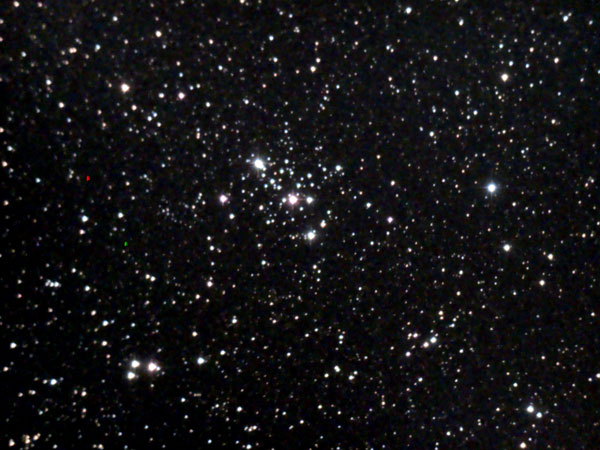 |
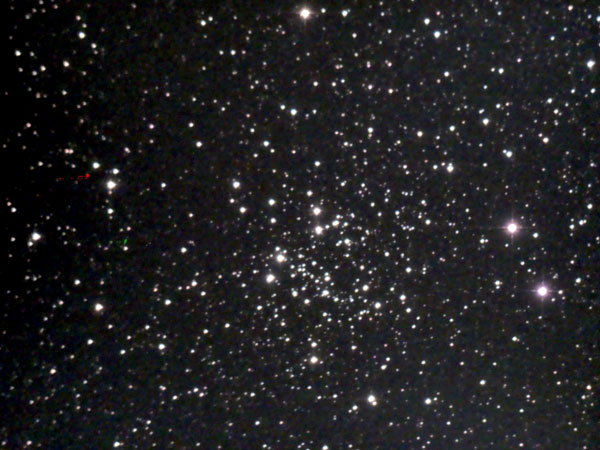 |
|||
M 52 - Aug 24, 2020, processed |
M 103 - Sep 7, 2020, processed | NGC 663 - Sep 7, 2020, processed |
||
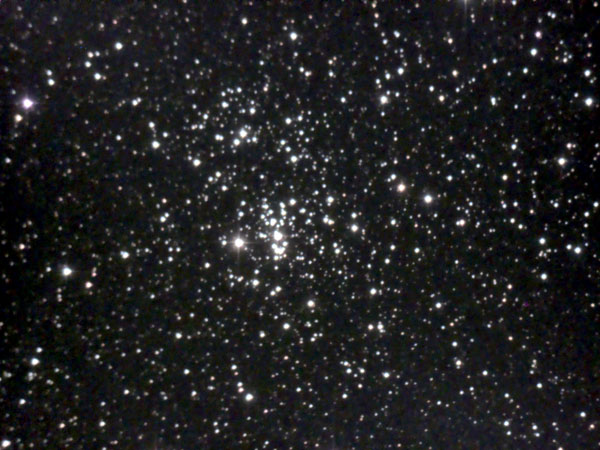 |
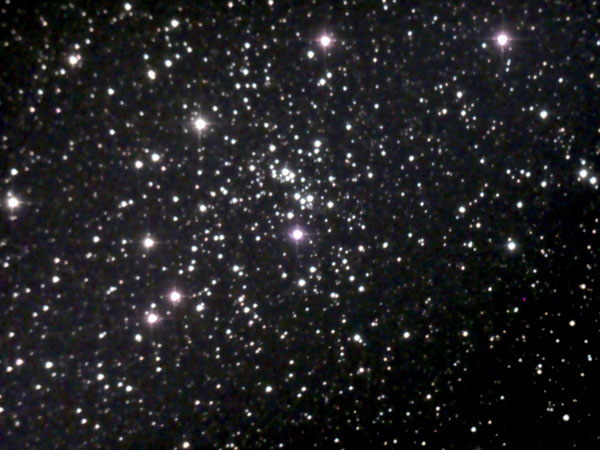 |
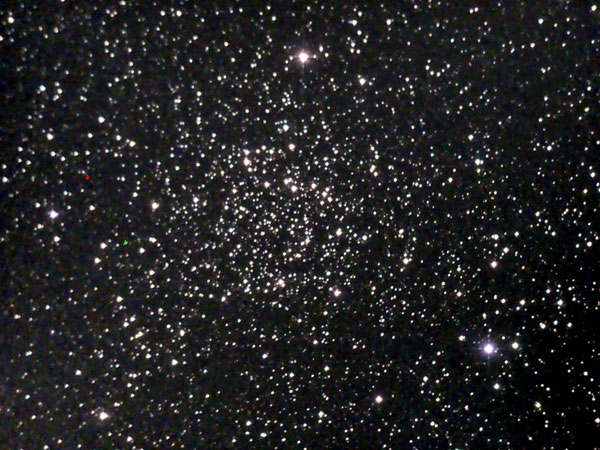 |
||
NGC 869 - Sep 12, 2020, processed |
NGC 884 - Sep 12, 2020, processed |
NGC 7789 - Sep 7, 2020, processed |
Here, I present photos of nice open star clusters - without any descriptions of the objects (these can be called using the links).
An Open Star Cluster Reminding of E.T. ...
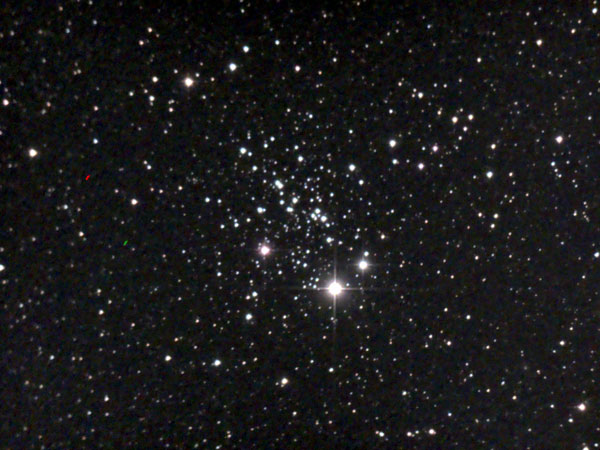 |
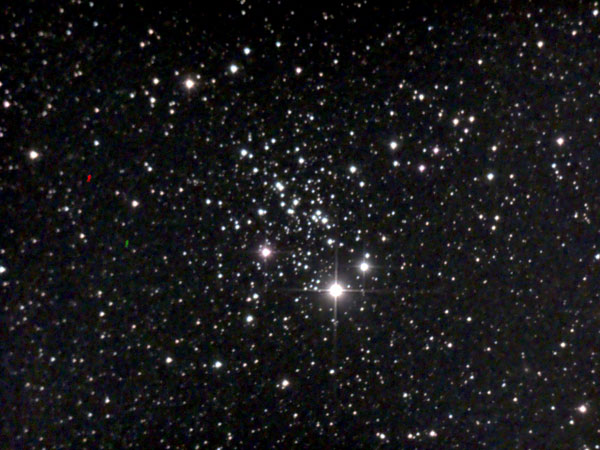 |
|
NGC 457 - Sep 7, 2020, processed |
NGC 457 - Sep 7, 2020, processed |
The open star cluster NGC 457 in the constellation Cassiopeia got its name Owl Cluster due to its characteristic shape; it is also called E.T. Cluster.
Links
- Unistellar Website: unistellaroptics.com
- eVscope Kickstarter campaign: www.kickstarter.com/projects/unistellar/evscope-100-times-more-powerful-than-a-classical-t/
- See also my page offering Astronomy Links.
| 11.06.2024 |
